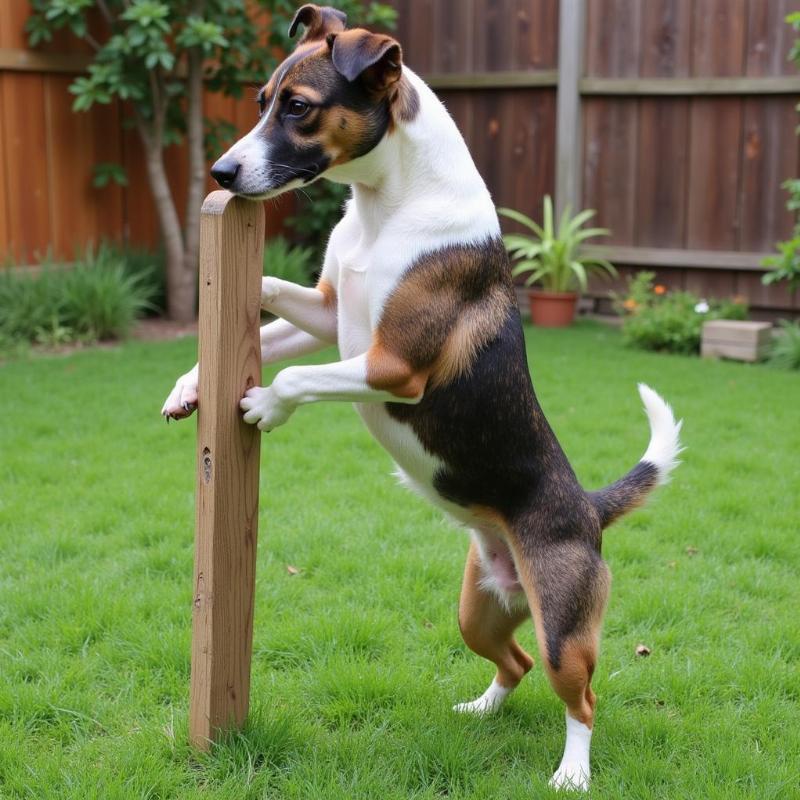Understanding your male dog’s instinct to mark territory is crucial for a harmonious home and peaceful walks. This natural behavior, often manifested through lifting a leg against a pee post or other vertical surfaces, can sometimes be a source of frustration for owners. This comprehensive guide will explore everything about pee posts for male dogs, from why they use them to how to choose the right one and train your dog effectively.
Why Do Male Dogs Use Pee Posts?
 Chó đực đang đi tiểu lên cột
Chó đực đang đi tiểu lên cột
Male dogs use pee posts primarily to mark their territory. This instinctual behavior communicates their presence to other dogs, establishing boundaries and social hierarchy. Urine contains pheromones, chemical signals that convey information about the dog’s age, health, and reproductive status. While all dogs, regardless of sex, use urine marking to some degree, it’s significantly more pronounced in intact males. Even neutered males often retain this behavior, albeit less frequently. They might also use pee posts simply because it feels good to stretch and lift their leg!
Choosing the Right Pee Post
The market offers a wide array of pee posts, designed to cater to different needs and preferences. Here’s a breakdown of the common types:
- Fire Hydrant Style: These mimic the classic fire hydrant, a favorite marking spot for many dogs. They’re usually made of durable plastic and are easy to clean.
- Wooden Posts: These offer a natural look and can blend seamlessly into your garden. Ensure the wood is treated to withstand weather and frequent urination.
- Plastic Posts: These are typically more affordable and come in various shapes and sizes. Look for sturdy options that won’t tip over easily.
Consider your dog’s size and the aesthetics of your yard when selecting a pee post. A larger dog will need a taller post to comfortably lift his leg.
Training Your Dog to Use a Pee Post
Introducing a pee post requires patience and consistency. Here’s a step-by-step guide:
- Place the post strategically: Choose a location in your yard where your dog frequently marks.
- Encourage sniffing and investigation: Reward your dog with praise and treats when he shows interest in the post.
- Capture the behavior: When your dog lifts his leg to urinate near the post, immediately guide him towards it.
- Positive reinforcement: Once he uses the post, reward him generously with praise, treats, and enthusiastic encouragement.
- Consistency is key: Consistently guide him to the post every time he needs to urinate. Avoid punishment, as this can create negative associations with the post.
Benefits of Using a Pee Post
Designated pee posts offer several advantages:
- Protects your landscaping: Concentrates urine marking to a specific area, preventing damage to plants and grass.
- Reduces territorial marking elsewhere: Provides an acceptable outlet for marking, minimizing unwanted behavior on walks.
- Easier cleanup: Makes cleaning up dog urine more manageable.
- Creates a routine: Helps establish a predictable bathroom routine for your dog.
Conclusion
Pee posts are a valuable tool for managing your male dog’s marking behavior. By understanding their natural instincts and implementing effective training techniques, you can create a more harmonious environment for both you and your furry friend. Choosing the right pee post and establishing a consistent routine will contribute significantly to a cleaner, happier, and more peaceful coexistence.
FAQ
- Do female dogs use pee posts? While less common, female dogs can also use pee posts, especially if they are dominant or have learned the behavior from male dogs.
- What if my dog still marks other areas after I introduce a pee post? Continued marking may indicate territorial insecurity or other underlying issues. Consult with a veterinarian or certified dog trainer for guidance.
- How often should I clean the pee post? Regular cleaning is essential to prevent odor buildup and maintain hygiene. Clean the post at least once a week using a pet-safe disinfectant.
- Can I use a natural object like a tree stump as a pee post? While possible, dedicated pee posts offer easier cleaning and maintenance.
- What if my dog is resistant to using the pee post? Patience and consistent positive reinforcement are crucial. Try different locations or types of pee posts to find what works best for your dog.
Beautdogs.us is your premier resource for all things dog-related in the US. We offer expert advice on dog breeds, care, and products, empowering both new and experienced dog owners to provide the best possible care for their furry companions. We are dedicated to promoting responsible dog ownership and celebrating the unique bond between humans and their canine friends. For expert advice tailored to your dog’s individual needs, reach out to our dedicated team. Email: [email protected], Phone: +1 501-555-7529. Visit Beautdogs.us today for more valuable insights!